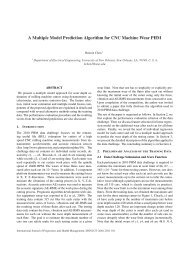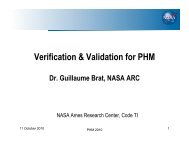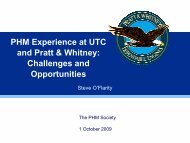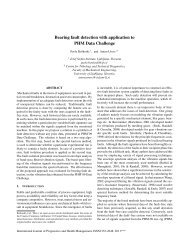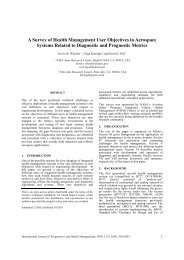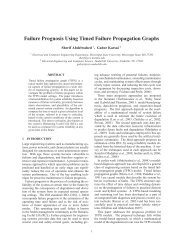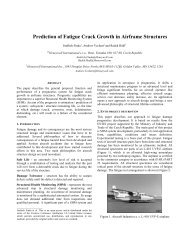PHM _2012_ - Batch detection algorithm installed on ... - PHM Society
PHM _2012_ - Batch detection algorithm installed on ... - PHM Society
PHM _2012_ - Batch detection algorithm installed on ... - PHM Society
Create successful ePaper yourself
Turn your PDF publications into a flip-book with our unique Google optimized e-Paper software.
A <str<strong>on</strong>g>Batch</str<strong>on</strong>g> Detecti<strong>on</strong> Algorithm Installed <strong>on</strong> a Test Bench<br />
Jérôme Lacaille 1 , Valerio Gerez 1<br />
1 Snecma, 77550 Moissy-Cramayel, France<br />
jerome.lacaille@snecma.fr<br />
valerio.gerez@snecma.fr<br />
ABSTRACT<br />
Test benches are used to evaluate the performance of new<br />
turbofan engine parts during development phases. This can<br />
be especially risky for the bench itself because no <strong>on</strong>e can<br />
predict in advance whether the comp<strong>on</strong>ent will behave<br />
properly. Moreover, a broken bench is often much more<br />
expensive than the deteriorati<strong>on</strong> of the comp<strong>on</strong>ent under<br />
test. Therefore, m<strong>on</strong>itoring this envir<strong>on</strong>ment is appropriate,<br />
but as the system is new, the <str<strong>on</strong>g>algorithm</str<strong>on</strong>g>s must automatically<br />
adapt to the comp<strong>on</strong>ent and to the driver's behavior who<br />
wants to experience the system at the edge of its normal<br />
domain.<br />
In this paper we present a novelty <str<strong>on</strong>g>detecti<strong>on</strong></str<strong>on</strong>g> <str<strong>on</strong>g>algorithm</str<strong>on</strong>g> used<br />
in batch mode at the end of each cycle. During a test cycle,<br />
the pilot increases the shaft speed by successive steps then<br />
finally ends the cycle by an equivalent slow descent. The<br />
<str<strong>on</strong>g>algorithm</str<strong>on</strong>g> takes a summary of the cycle and works at a cycle<br />
frequency producing <strong>on</strong>ly <strong>on</strong>e result at the end of each<br />
cycle. Its goal is to provide an indicati<strong>on</strong> to the pilot <strong>on</strong> the<br />
reliability of the bench's use for a next cycle.<br />
1. INTRODUCTION<br />
This document follows two previous articles published in<br />
2010 and 2011 in the <str<strong>on</strong>g>PHM</str<strong>on</strong>g> <strong>Society</strong>. The first <strong>on</strong>e (Lacaille<br />
& Gerez & Zouari, 2010b) presents the health-m<strong>on</strong>itoring<br />
architecture we deploy <strong>on</strong> <strong>on</strong>e of our test benches and gives<br />
clues about adaptati<strong>on</strong> to c<strong>on</strong>text changes in the use of the<br />
machine. We proposed an <str<strong>on</strong>g>algorithm</str<strong>on</strong>g>ic soluti<strong>on</strong> using<br />
simultaneously an autoadaptive clustering <str<strong>on</strong>g>algorithm</str<strong>on</strong>g> and<br />
local <str<strong>on</strong>g>detecti<strong>on</strong></str<strong>on</strong>g> tools calibrated <strong>on</strong> each cluster. In the<br />
sec<strong>on</strong>d paper (Lacaille & Gerez, 2011c) a lighter soluti<strong>on</strong><br />
based <strong>on</strong> similitude computati<strong>on</strong>s and nearest neighbor<br />
<str<strong>on</strong>g>algorithm</str<strong>on</strong>g>s was given. This implementati<strong>on</strong> was essentially<br />
given to be embedded in the FADEC computer of the<br />
engine. In fact the <str<strong>on</strong>g>algorithm</str<strong>on</strong>g>s used <strong>on</strong> test benches are also<br />
_____________________<br />
Jérôme Lacaille et al. This is an open-access article distributed under the<br />
terms of the Creative Comm<strong>on</strong>s Attributi<strong>on</strong> 3.0 United States License,<br />
which permits unrestricted use, distributi<strong>on</strong>, and reproducti<strong>on</strong> in any<br />
medium, provided the original author and source are credited.<br />
good prototypes for <strong>on</strong>line soluti<strong>on</strong>s. It’s why a fast soluti<strong>on</strong><br />
needed to be developed to check if it could also work <strong>on</strong><br />
dedicated hardware when the engine is <str<strong>on</strong>g>installed</str<strong>on</strong>g> under an<br />
aircraft wing.<br />
Those two previous propositi<strong>on</strong>s deal with <strong>on</strong>line<br />
abnormality <str<strong>on</strong>g>detecti<strong>on</strong></str<strong>on</strong>g>: during the executi<strong>on</strong> of the test. They<br />
essentially detect fleeting events that suddenly appears<br />
without more warning. This paper presents a soluti<strong>on</strong> for an<br />
off line analysis. The <str<strong>on</strong>g>algorithm</str<strong>on</strong>g> was already implemented in<br />
a lighter form <strong>on</strong> operati<strong>on</strong>al data broadcasted via SatCom<br />
(as ACARS messages) to the ground. This limited versi<strong>on</strong><br />
of the <str<strong>on</strong>g>algorithm</str<strong>on</strong>g>s was partly described in (Lacaille, 2009c),<br />
the current propositi<strong>on</strong> deals with automatic <str<strong>on</strong>g>detecti<strong>on</strong></str<strong>on</strong>g> of<br />
stati<strong>on</strong>ary levels, building of temporal snapshots, analysis of<br />
the ground database of such snapshots with a clustering<br />
<str<strong>on</strong>g>algorithm</str<strong>on</strong>g> to detect recurrent c<strong>on</strong>figurati<strong>on</strong>s, and the novelty<br />
<str<strong>on</strong>g>detecti<strong>on</strong></str<strong>on</strong>g> <str<strong>on</strong>g>algorithm</str<strong>on</strong>g>. Figure 1 shows the OSA-CBM<br />
decompositi<strong>on</strong> of each layer of the <str<strong>on</strong>g>algorithm</str<strong>on</strong>g>.<br />
Figure 1: OSA-CBM architecture of the <str<strong>on</strong>g>algorithm</str<strong>on</strong>g>.
Annual C<strong>on</strong>ference of Prognostics and Health Management <strong>Society</strong> <str<strong>on</strong>g>2012</str<strong>on</strong>g><br />
Figure 2: Deployment of the <str<strong>on</strong>g>PHM</str<strong>on</strong>g> system <strong>on</strong> a distinct server.<br />
The health-m<strong>on</strong>itoring <str<strong>on</strong>g>algorithm</str<strong>on</strong>g>s are developed by Snecma<br />
under the SAMANTA platform which was previously<br />
described in (Lacaille, 2009b). This envir<strong>on</strong>ment<br />
industrializes blocs of mathematic processing tools in<br />
graphical units. Aer<strong>on</strong>autic engineers are able to exploit<br />
each mathematic module to build their own specific<br />
soluti<strong>on</strong>s. In our case this method uses signal filters to<br />
prepare the data, a stati<strong>on</strong>ary process detector, a clustering<br />
tool, some regressi<strong>on</strong> and dimensi<strong>on</strong> reducti<strong>on</strong> <str<strong>on</strong>g>algorithm</str<strong>on</strong>g>s to<br />
help normalize observati<strong>on</strong>s and make them as much<br />
independent of the acquisiti<strong>on</strong> c<strong>on</strong>text (bench cell driving)<br />
as possible. For the novelty <str<strong>on</strong>g>detecti<strong>on</strong></str<strong>on</strong>g> part, it uses a score<br />
computati<strong>on</strong>, a threshold based c<strong>on</strong>figurable statistic test<br />
and a diagnosis c<strong>on</strong>firmati<strong>on</strong> tool. The two first OSA-CBM<br />
layers (mostly signal filtering) are assembled apart from the<br />
rest of the <str<strong>on</strong>g>algorithm</str<strong>on</strong>g>. They produce an off line database of<br />
snapshots which is processed by the learning phase of the<br />
analysis layer (#3). The results from the data-driven part and<br />
the statistic test in last layer (#4) produce the diagnosis.<br />
SAMANTA platform embed also some automatic validati<strong>on</strong><br />
layers (see Lacaille, 2010a and <str<strong>on</strong>g>2012</str<strong>on</strong>g>) that helps compute<br />
key performance indicators (with precisi<strong>on</strong>) using crossvalidati<strong>on</strong><br />
schemes.<br />
2. CONTEXT OF APPLICATION<br />
A turbofan development test bench is subject to lots of<br />
changes in behavior. The interacti<strong>on</strong> between pilot and<br />
engineers is really tense and the system may be stopped at<br />
any instant if some analyst finds an abnormality in the<br />
observati<strong>on</strong>s. The sensors are directly broadcasted to<br />
observati<strong>on</strong>s c<strong>on</strong>soles and validated numeric soluti<strong>on</strong>s may<br />
launch alarms. The health-m<strong>on</strong>itoring goal is not to stop the<br />
process but to provide informati<strong>on</strong> about the health of the<br />
test bench itself (or the tested engine part, but we give a lot<br />
more attenti<strong>on</strong> to the bench which is more expensive and<br />
less damageable than the tested prototypes).<br />
2.1. Implementati<strong>on</strong> in the test cell<br />
To minimize interacti<strong>on</strong>s between the driving of the system<br />
and the <str<strong>on</strong>g>PHM</str<strong>on</strong>g> <str<strong>on</strong>g>algorithm</str<strong>on</strong>g>s we implement an executi<strong>on</strong> driver<br />
of our SAMANTA platform <strong>on</strong> a separate server with a<br />
local memory buffer able to deal with days of high<br />
frequency acquisiti<strong>on</strong> data (50kHz) and weeks of low<br />
frequency acquisiti<strong>on</strong> (10Hz) and enough storage space to<br />
manage a big database of snapshots (some data vectors per<br />
cycle – with <strong>on</strong>e or two cycles each day).<br />
2.2. Reliability computati<strong>on</strong><br />
The <str<strong>on</strong>g>PHM</str<strong>on</strong>g> <str<strong>on</strong>g>algorithm</str<strong>on</strong>g>s should present computati<strong>on</strong> results<br />
with a minimum of reliability because we d<strong>on</strong>’t want to<br />
interrupt an expensive test experiment scheduled for weeks<br />
or m<strong>on</strong>ths with bad reas<strong>on</strong>s. Hence a very important<br />
attenti<strong>on</strong> is given to the false alarm performance indicator<br />
(PFA). The other indicator we follow is the probability of<br />
<str<strong>on</strong>g>detecti<strong>on</strong></str<strong>on</strong>g> (POD). It is a lot easier to compute because we<br />
have some past logbooks <strong>on</strong> which all historical events<br />
where recorded. The main job in that case was to label those<br />
(handwritten) data and to compute the <str<strong>on</strong>g>detecti<strong>on</strong></str<strong>on</strong>g> rate <strong>on</strong> past<br />
tests.<br />
The PFA indicator is given by Eq. (1). If <strong>on</strong>e writes<br />
P( ) the probability that an abnormality is detected<br />
by the <str<strong>on</strong>g>algorithm</str<strong>on</strong>g>, P( h ) the probability that the<br />
system is healthy. Then the false alarm rate is just the<br />
probability that the system is healthy but that an<br />
abnormality is detected. It is represented as the following<br />
c<strong>on</strong>diti<strong>on</strong>al probability:<br />
= P( h | ) (1)<br />
This is clearly different from the usual<br />
= P(Detected|Healthy) which is the first species statistic<br />
error that <strong>on</strong>e needs to calibrate to define the test rejecti<strong>on</strong><br />
domain. This PFA value really represents the inc<strong>on</strong>venience<br />
of stopping a test for no reas<strong>on</strong>.<br />
The probability of <str<strong>on</strong>g>detecti<strong>on</strong></str<strong>on</strong>g> is simply given by Eq. (2):<br />
2
Annual C<strong>on</strong>ference of Prognostics and Health Management <strong>Society</strong> <str<strong>on</strong>g>2012</str<strong>on</strong>g><br />
= P( | ) (2)<br />
It is the standard 1 − value, usually called “test power” in<br />
statistical background.<br />
PFA can also be rewritten according to Bayes’ rule and a<br />
computati<strong>on</strong> of in Eq. (3) shows that the test threshold<br />
should be chosen very far from normal behavior when <strong>on</strong>e<br />
intends to respect a small boundary c<strong>on</strong>straint <strong>on</strong> the false<br />
alarm rate:<br />
= ⋅ 1 −<br />
⋅ 1 −<br />
≃ × × (3)<br />
where = P( ) is usually very small for aircraft<br />
engine parts (less than 10 -6 per hour). A very careful<br />
attenti<strong>on</strong> is needed for the choice of this <str<strong>on</strong>g>detecti<strong>on</strong></str<strong>on</strong>g> threshold.<br />
It is why the decisi<strong>on</strong> part of the <str<strong>on</strong>g>algorithm</str<strong>on</strong>g> has two<br />
additi<strong>on</strong>al modules: <strong>on</strong>e for c<strong>on</strong>firmati<strong>on</strong> by several<br />
successive <str<strong>on</strong>g>detecti<strong>on</strong></str<strong>on</strong>g>s and another for the optimizati<strong>on</strong> of the<br />
threshold, using a model of the score distributi<strong>on</strong> queue with<br />
Parzen windows.<br />
Figure 3 shows the meaning of the rejecti<strong>on</strong> threshold<br />
computed from a choice of and the power 1 − of a<br />
statistical test.<br />
Index<br />
ESN<br />
Engine serial number<br />
CYCL<br />
Engine cycle reference<br />
DATE<br />
Date of cycle (start to off)<br />
N° Sensor Label Unit<br />
01 XN Shaft rotati<strong>on</strong> speed tr/min<br />
02 XN_DERIV Accel. of the rotati<strong>on</strong> -<br />
03 TORQUE UI/w kg/h<br />
04 P4 Pressure Pist<strong>on</strong> #4 bar<br />
05 PORSDE Positi<strong>on</strong> rectifier deg<br />
06 VANPRIM Positi<strong>on</strong> primary vane %<br />
07 P1 Pressure Pist<strong>on</strong> #1 bar<br />
08 K_0N Disp. Up Pilot mmDA<br />
09 K_0T Disp. Up RMS mmDA<br />
10 K_1N Disp. Down Pilot mmDA<br />
11 K_1T Disp. Down RMS mmDA<br />
12 ACC_4RN Accel. #4 Rad Pilot cm/s eff<br />
13 ACC_4RT Accel. #4 Rad RMS cm/s eff<br />
14 T4 Temp. #4 degC<br />
15 ACC_1HN Accel. #1 Horiz Pilot cm/s eff<br />
16 ACC_2VN Accel. #2 Vert Pilot cm/s eff<br />
17 ACC_3VN Accel. #3 Vert Pilot cm/s eff<br />
18 ACC_MN Accel. Engine Pilot cm/s eff<br />
19 ACC_1HT Accel. #1 Horiz RMS cm/s eff<br />
20 ACC_2VT Accel. #2 Vert RMS cm/s eff<br />
21 ACC_3VT Accel. #3 Vert RMS cm/s eff<br />
22 T1 Temp. #1 degC<br />
23 ACC_MT Accel. Engine RMS cm/s eff<br />
24 T2 Temp. #2 degC<br />
25 T3 Temp. #3 degC<br />
Table 1: List of sensors and corresp<strong>on</strong>ding units, blue and<br />
green backgrounds identify respectively a selecti<strong>on</strong> for the<br />
exogenous and endogenous variables.<br />
Figure 3: Threshold selecti<strong>on</strong> for decisi<strong>on</strong> test.<br />
2.3. Descripti<strong>on</strong> of the bench data<br />
The main element we have to m<strong>on</strong>itor is the rotating shaft<br />
and the principal bearing (called #4 here). One of the<br />
exogenous informati<strong>on</strong> we have to deal with is the external<br />
loading applied <strong>on</strong> the right of this shaft. This is a<br />
l<strong>on</strong>gitudinal force which have a lot of influence <strong>on</strong> the<br />
system behavior because it may change the dynamic mode<br />
positi<strong>on</strong>s.<br />
Most measurements come from dynamic high frequency<br />
acquisiti<strong>on</strong>s. The corresp<strong>on</strong>ding low-frequency observati<strong>on</strong>s<br />
are filtered energy computati<strong>on</strong>s which may be either<br />
piloted by the shaft speed or be total vibrati<strong>on</strong> energy,<br />
eventually quantified according to given bandwidths.<br />
The table below (Table 1) gives the complete list of used<br />
sensors.<br />
The #1 to #4 numbers refer to the different bearings where<br />
accelerometers are measuring vibrati<strong>on</strong> data. Those<br />
vibrati<strong>on</strong> values are summarized as local energies for a<br />
frequency band that corresp<strong>on</strong>ds to the shaft speed (N) or a<br />
total amount of energy (T). The first sensors (blue<br />
background) are used as c<strong>on</strong>text informati<strong>on</strong> or exogenous<br />
variables. The corresp<strong>on</strong>ding data vector is used to identify<br />
the c<strong>on</strong>text of the measurement. They are used to select<br />
stati<strong>on</strong>ary snapshots and to classify the snapshots into<br />
clusters. The others variables (endogenous) are used to<br />
m<strong>on</strong>itor the bench when a c<strong>on</strong>text is clearly identified.<br />
Other variables such as microph<strong>on</strong>e band energies are not<br />
displayed in Table 1. Such selecti<strong>on</strong> of endogenous and<br />
exogenous variables defines an instance of the <str<strong>on</strong>g>algorithm</str<strong>on</strong>g>. It<br />
is possible to build different kind of instances (with<br />
corresp<strong>on</strong>ding <str<strong>on</strong>g>algorithm</str<strong>on</strong>g>ic parameters) for any part of the<br />
test bench <strong>on</strong>e selects to m<strong>on</strong>itor.<br />
The abnormalities may be very tricky to detect. For example<br />
<strong>on</strong> Figure 4 <strong>on</strong>e can see measurements taken during a test<br />
cycle that c<strong>on</strong>tains such anomaly. Just looking the data is<br />
rarely sufficient to find the abnormal behavior. A<br />
mathematic comparative analysis is definitely needed.<br />
3
Annual C<strong>on</strong>ference of Prognostics and Health Management <strong>Society</strong> <str<strong>on</strong>g>2012</str<strong>on</strong>g><br />
Shaft speed (XN)<br />
Disp<br />
Accel.<br />
Figure 4: Example of measurements acquired during a<br />
whole cycle. The black stepwise line represents the shaft<br />
speed. Displacement (light blue and green) and<br />
accelerometers (dark blue and magenta) are highlighted.<br />
The other blue sensor is the load (the last data have no<br />
meaning since the shaft stopped). An abnormality is hidden<br />
in those data.<br />
Figure 6: Example of snapshots identificati<strong>on</strong>, each star<br />
represents a point detected as a possible snapshot for the test<br />
cycle.<br />
3.2. Novelty <str<strong>on</strong>g>detecti<strong>on</strong></str<strong>on</strong>g><br />
The <str<strong>on</strong>g>detecti<strong>on</strong></str<strong>on</strong>g> part uses three mathematic models: the<br />
clustering <str<strong>on</strong>g>algorithm</str<strong>on</strong>g>, the score <str<strong>on</strong>g>algorithm</str<strong>on</strong>g> and the decisi<strong>on</strong><br />
<str<strong>on</strong>g>algorithm</str<strong>on</strong>g>. Each <strong>on</strong>e needs a specific learning phase to<br />
calibrate.<br />
3. ALGORITHMS DESCRIPTION<br />
The <str<strong>on</strong>g>algorithm</str<strong>on</strong>g> is made of two parts. The first <strong>on</strong>e identifies<br />
stati<strong>on</strong>ary measurement intervals (in c<strong>on</strong>text data) and<br />
builds a snapshot of the endogenous measurements. The<br />
sec<strong>on</strong>d part loads the database of snapshots, builds clusters,<br />
and for each cluster search for abnormalities.<br />
3.1. Snapshots extracti<strong>on</strong><br />
Figure 5: Graph of SAMANTA modules to extract<br />
snapshots and build a database.<br />
The first step of snapshot extracti<strong>on</strong> is the selecti<strong>on</strong> of<br />
measurements to identify stati<strong>on</strong>ary data. The stati<strong>on</strong>ary<br />
measurement detector waits for a main c<strong>on</strong>trol value to be<br />
almost c<strong>on</strong>stant and tests a vector of endogenous<br />
measurements for sec<strong>on</strong>d order statistic stati<strong>on</strong>arity. In our<br />
case we use the shaft speed as main c<strong>on</strong>trol and test other<br />
endogenous data for stati<strong>on</strong>arity.<br />
Once a stable point detected, a buffer of observati<strong>on</strong>s is<br />
recorded and defines the snapshot. Figure 6 shows a list of<br />
snapshots detected <strong>on</strong> a symbolic cycle that may represent a<br />
real flight.<br />
Figure 7: The novelty <str<strong>on</strong>g>detecti<strong>on</strong></str<strong>on</strong>g> graph of SAMANTA<br />
modules.<br />
The clustering learning phase uses the whole snapshot<br />
database (eventually obtained from a sub-sampling of the<br />
snapshot buffers) but <strong>on</strong>ly exogenous vectors of values to<br />
isolate homogeneous clusters with an EM <str<strong>on</strong>g>algorithm</str<strong>on</strong>g>. This<br />
<str<strong>on</strong>g>algorithm</str<strong>on</strong>g>, as described in (Lacaille et al. 2010b), is a<br />
generative statistic model from a mixture of Gaussian<br />
distributi<strong>on</strong>s. Each Gaussian identifies a different set of<br />
snapshots. The number of classes is estimated by a BIC<br />
criteri<strong>on</strong> and the unclassed snapshots are not used.<br />
During the learning phase a database of snapshot buffers is<br />
used to define the individual classes which can eventually<br />
further be labeled as flight regimes or operating modes. To<br />
make this possible, each buffer signal curve is compressed<br />
into a set of shape indicators hence replacing the<br />
multivariate temporal signal by a vector of indicators U. The<br />
compressi<strong>on</strong> scheme (Figure 8) uses specific <str<strong>on</strong>g>algorithm</str<strong>on</strong>g>s to<br />
enlighten changes in the data: for examples an <str<strong>on</strong>g>algorithm</str<strong>on</strong>g><br />
computes the trend of the signal, another looks for jumps<br />
and a generic compressi<strong>on</strong> uses automatic templates built<br />
from a principal comp<strong>on</strong>ent analysis (PCA).<br />
4
Annual C<strong>on</strong>ference of Prognostics and Health Management <strong>Society</strong> <str<strong>on</strong>g>2012</str<strong>on</strong>g><br />
functi<strong>on</strong> of endogenous parameters) for all snapshots i of a<br />
given cluster.<br />
Arg min ∑ , − ∑ , subject to ∑ | | < (4)<br />
Figure 8: Compressi<strong>on</strong> process that builds indicators from a<br />
multivariate temporal buffer.<br />
The set of exogenous indicator vector U is then used by the<br />
classificati<strong>on</strong> <str<strong>on</strong>g>algorithm</str<strong>on</strong>g> to build classes as a mixture of<br />
Gaussians. The number of classes to build is c<strong>on</strong>trolled by a<br />
BIC criteri<strong>on</strong> but may be also given by expert bounds as the<br />
snapshots are essentially identified as standard layers.<br />
Each set of classed snapshots (the <strong>on</strong>es that bel<strong>on</strong>g to a<br />
cluster) are used to calibrate a score model. Once<br />
indentified in a specific class, each multivariate temporal<br />
signal of endogenous data is compressed locally in another<br />
indicator vector Y (Figure 9). The score process has two<br />
steps; the first <strong>on</strong>e normalizes the endogenous data<br />
suppressing disparities due to little variati<strong>on</strong>s in the c<strong>on</strong>text.<br />
This is d<strong>on</strong>e by a regressi<strong>on</strong> <str<strong>on</strong>g>algorithm</str<strong>on</strong>g> c<strong>on</strong>trolled by a L 1<br />
criteri<strong>on</strong> (LASSO <str<strong>on</strong>g>algorithm</str<strong>on</strong>g>) as described in (Lacaille &<br />
Côme, 2011b). The sec<strong>on</strong>d step is a model of the residual of<br />
this regressi<strong>on</strong> by a Gaussian score (a Mahalanobis<br />
distance) see (Lacaille, 2009c).<br />
The final and optimal c<strong>on</strong>stant C is chosen such that the<br />
generalizati<strong>on</strong> error of the regressi<strong>on</strong> is the smallest. The<br />
generalizati<strong>on</strong> error is computed by a cross validati<strong>on</strong><br />
scheme. The next graph (Figure 10) explains in 2<br />
dimensi<strong>on</strong>s why the c<strong>on</strong>straint is to be chosen in absolute<br />
value instead of Euclidian norm. The figure schematizes the<br />
mean square regressi<strong>on</strong> coefficient as the point and isosquare<br />
errors as red ellipses (first part of equati<strong>on</strong> 4). The<br />
blue shapes (disk for L 2 c<strong>on</strong>strain and square for L 1<br />
c<strong>on</strong>straint) represents the value of the sec<strong>on</strong>d part of<br />
equati<strong>on</strong> 4. The value to select is <strong>on</strong> a tangent intersecti<strong>on</strong><br />
of an ellipse (ellipsoid in higher dimensi<strong>on</strong>) and the surface<br />
of the blue shape. The radius of the ellipse is the square<br />
error and the radius of the blue shape is the c<strong>on</strong>straint. It<br />
appears clearly that with a square (cube, hypercube) the<br />
chance to find an edge point of the surface is important. As<br />
so<strong>on</strong> as those points are <strong>on</strong> the main axis, most of the<br />
coefficients of should be zero.<br />
Figure 9: Score analysis after snapshot identificati<strong>on</strong>.<br />
Equati<strong>on</strong> 4 explains the mathematics of the regressi<strong>on</strong><br />
model. Each parameter , corresp<strong>on</strong>d to a combinati<strong>on</strong> j,<br />
n<strong>on</strong> necessary linear, of exogenous variables in U used to<br />
predict endogenous observati<strong>on</strong> , of parameter k (or a<br />
Figure 10: Minimizati<strong>on</strong> subject to L 1 c<strong>on</strong>straint (absolute<br />
value) instead of a L 2 c<strong>on</strong>straint (Euclidian norm) ensures<br />
that most coefficients are set to zero, hence improving the<br />
regressi<strong>on</strong> robustness with a small loss in mean square error.<br />
As this model automatically selects variables to ensure a<br />
good robustness, we may use a big set of computati<strong>on</strong>s as<br />
inputs. In fact the aer<strong>on</strong>autic experts give clues about the<br />
physic process and help the c<strong>on</strong>cepti<strong>on</strong> of a big vector X of<br />
indicator functi<strong>on</strong>s that makes a great uses of formal<br />
physical equati<strong>on</strong>s.<br />
The final score s of a single observati<strong>on</strong> is given by (Eq. 5)<br />
where = − is the residual of the preceding<br />
regressi<strong>on</strong> for a variable k and a current snapshot and Σ is<br />
the matrix of covariance of the vector = ( ).<br />
= Σ (5)<br />
The score should follow a standard χ distributi<strong>on</strong> under<br />
very restrictive c<strong>on</strong>straints <strong>on</strong> the model and residual<br />
distributi<strong>on</strong>. In general those c<strong>on</strong>straints are not completely<br />
respected, and in any cases as the real dimensi<strong>on</strong>ality of the<br />
problem stays approximate, an indeterminati<strong>on</strong> of the<br />
freedom level is possible. We use a last module of <str<strong>on</strong>g>algorithm</str<strong>on</strong>g><br />
to establish a more precise decisi<strong>on</strong> rule. This decisi<strong>on</strong> rule<br />
5
Annual C<strong>on</strong>ference of Prognostics and Health Management <strong>Society</strong> <str<strong>on</strong>g>2012</str<strong>on</strong>g><br />
is not <strong>on</strong>ly based <strong>on</strong> <strong>on</strong>e score computati<strong>on</strong> but <strong>on</strong> a small<br />
list of successive scores. Each individual score is compared<br />
to a threshold and the Boolean results are combined<br />
together by a vote process. The law of the scores is modeled<br />
with Parzen windows <strong>on</strong> healthy observati<strong>on</strong>s. Then<br />
artificial abnormal behaviors are produced with the help of<br />
aer<strong>on</strong>autic experts and a mechanical physic simulator. Using<br />
the empirical distributi<strong>on</strong> of scores and the pseudo abnormal<br />
observati<strong>on</strong>s <strong>on</strong>e is able to determine a good choice for the<br />
threshold for a given computed from equati<strong>on</strong> 3.<br />
4. RESULTS AND CONCLUSION<br />
Two campaigns of measurements where d<strong>on</strong>e <strong>on</strong> the same<br />
bench test cell. The first <strong>on</strong>e was to challenge a civilian<br />
compressor and lasted almost 3 m<strong>on</strong>ths. It was a bench<br />
calibrati<strong>on</strong> test. The sec<strong>on</strong>d campaign uses a military<br />
compressor as an extractor for another development bench,<br />
we get also around 3 m<strong>on</strong>ths of data. In each case, when the<br />
bench was working we may have <strong>on</strong>e to three runs per day.<br />
Results cannot be presented in this article; the main goal for<br />
the <str<strong>on</strong>g>PHM</str<strong>on</strong>g> team was to validate the <str<strong>on</strong>g>algorithm</str<strong>on</strong>g> and the<br />
m<strong>on</strong>itoring process.<br />
4.1. Examples of detected abnormalities<br />
Example 1. Normally, during a stabilized step, if the axial<br />
pressure <strong>on</strong> the shaft increases, the vibrati<strong>on</strong> level should<br />
decrease. It was not the case <strong>on</strong> Figure 11 and this was<br />
detected as an abnormal feature.<br />
Figure 12: A sudden augmentati<strong>on</strong> of vibrati<strong>on</strong> was detected<br />
by vibrati<strong>on</strong> sensors (red and blue) during a decelerati<strong>on</strong><br />
(shaft speed in green).<br />
4.2. C<strong>on</strong>clusi<strong>on</strong><br />
The work was tested <strong>on</strong> data obtained during the 6 m<strong>on</strong>ths<br />
of experimentati<strong>on</strong>. The PFA indicators were computed <strong>on</strong><br />
observed data with the prerequisite identificati<strong>on</strong> of all the<br />
real abnormalities referenced in the logbook. Then new<br />
simulated defects compatible with the real observati<strong>on</strong>s<br />
were artificially added to the data at known random<br />
positi<strong>on</strong>s <strong>on</strong> the signals. A false alarm rate of PFA=1.3%<br />
and a <str<strong>on</strong>g>detecti<strong>on</strong></str<strong>on</strong>g> rate of POD=78% were obtained <strong>on</strong> high<br />
speed rotati<strong>on</strong> clusters. On low speed clusters, too much<br />
variability of the endogenous variables was observed to give<br />
c<strong>on</strong>clusive results. More work will be d<strong>on</strong>e <strong>on</strong> the<br />
identificati<strong>on</strong> of specific recurrent clusters, but in any cases<br />
the <str<strong>on</strong>g>algorithm</str<strong>on</strong>g> may still be used if some standard states are<br />
defined, and if <strong>on</strong>e asks the pilot to reach those states at the<br />
beginning of each run.<br />
Another model should also be defined for n<strong>on</strong>-stati<strong>on</strong>ary<br />
measurements because some known difficulties may arise<br />
when the bench crosses a vibrati<strong>on</strong> mode during a transient<br />
phase such as accelerati<strong>on</strong> or decelerati<strong>on</strong>.<br />
Figure 11: On that test run the vibrati<strong>on</strong> level, measured by<br />
an accelerometer (light blue), decreases when the pressure<br />
augments (dark blue) and during a stabilized level (XN in<br />
green).<br />
Example 2. Figure 12 shows a sudden increase of the total<br />
vibrati<strong>on</strong> levels during a decelerati<strong>on</strong> phase. This is also<br />
another kind of abnormal behavior which was not detected<br />
at first because the system was not able to differentiate<br />
between main accelerati<strong>on</strong>s and decelerati<strong>on</strong> (begin or end<br />
of the run), but as so<strong>on</strong> as we enter this informati<strong>on</strong> as a<br />
c<strong>on</strong>text observati<strong>on</strong> the <str<strong>on</strong>g>detecti<strong>on</strong></str<strong>on</strong>g> is fixed.<br />
NOMENCLATURE<br />
BIC Bayesian Informati<strong>on</strong> Criteri<strong>on</strong><br />
LASSO Least Absolute Shrinkage and Selecti<strong>on</strong><br />
Operator<br />
FADEC Full Authority Digital Engine C<strong>on</strong>trol<br />
OSA-CBM Open Systems Architecture for C<strong>on</strong>diti<strong>on</strong>-based<br />
Maintenance<br />
PFA Probability of False Alarm<br />
POD Probability Of Detecti<strong>on</strong><br />
SAMANTA Snecma Algorithm Maturati<strong>on</strong> And Test<br />
Applicati<strong>on</strong><br />
REFERENCES<br />
Bellas, A. & Bouveyr<strong>on</strong>, Ch. & Cottrell, M. & Lacaille, J.<br />
(<str<strong>on</strong>g>2012</str<strong>on</strong>g>), Robust Clustering of High Dimensi<strong>on</strong>al Data.<br />
In proceedings of ESANN, Bruges, Belgium.<br />
6
Annual C<strong>on</strong>ference of Prognostics and Health Management <strong>Society</strong> <str<strong>on</strong>g>2012</str<strong>on</strong>g><br />
Blanchard, S. & Lacaille, J. & Cottrell, M. (2009), Health<br />
m<strong>on</strong>itoring des moteurs d’avi<strong>on</strong>s. In « Les entretiens de<br />
Toulouse », France.<br />
Cômes, E. & Cottrell, M. & Verleysen, M. & Lacaille, J.<br />
(2010a), Aircraft engine health m<strong>on</strong>itoring using selforganizing<br />
maps. In proceedings of ICDM, Berlin,<br />
Germany.<br />
Cômes, E. & Cottrell, M. & Verleysen, M. & Lacaille, J.<br />
(2010b), Self organizing star (sos) for health<br />
m<strong>on</strong>itoring. In proceedings of ESANN, Bruges,<br />
Belgium.<br />
Cômes, E. & Cottrell, M. & Verleysen, M. & Lacaille. J.<br />
(2011), Aircraft engine fleet m<strong>on</strong>itoring using Self-<br />
Organizing Maps and Edit Distance. In WSOM<br />
proceedings, Espoo, Finland.<br />
Cottrell, M. & Gaubert, P. & Eloy, C. & François, D. &<br />
Hallaux, G. & Lacaille, J. & Verleysen, M. (2009),<br />
Fault predicti<strong>on</strong> in aircraft engines using selforganizing<br />
maps. In proceedings of WSOM, Miami,<br />
FL.<br />
Flandrois, X. & Lacaille, J. (2009), Expertise transfer and<br />
automatic failure classificati<strong>on</strong> for the engine start<br />
capability system. In proceedings of AIAA Infotech,<br />
Seattle, WA.<br />
Hazan, A. & Verleysen, M. & Cottrell, M. & Lacaille, J.<br />
(2010a), Trajectory clustering for vibrati<strong>on</strong> <str<strong>on</strong>g>detecti<strong>on</strong></str<strong>on</strong>g> in<br />
aircraft engines. In proceedings of ICDM, Berlin,<br />
Germany.<br />
Hazan, A. & Verleysen, M. & Cottrell, M. & Lacaille, J.<br />
(2010b), Linear smoothing of FRF for aircraft engine<br />
vibrati<strong>on</strong> m<strong>on</strong>itoring. In proceedings of ISMA,<br />
Louvain.<br />
Hazan, A. & Lacaille, J. & Madani, K. (<str<strong>on</strong>g>2012</str<strong>on</strong>g>), Extreme<br />
value statistics for vibrati<strong>on</strong> spectra outlier <str<strong>on</strong>g>detecti<strong>on</strong></str<strong>on</strong>g>.<br />
In proceedings of CM-MFPT, L<strong>on</strong>d<strong>on</strong>, UK.<br />
Klein, R. (2009), Model based approach for identificati<strong>on</strong><br />
of gears and bearings failure modes. In proceedings of<br />
<str<strong>on</strong>g>PHM</str<strong>on</strong>g> <strong>Society</strong> C<strong>on</strong>ference, San Diego, CA.<br />
Lacaille, J. & R. Nya-Djiki, R. (2009), Model based<br />
actuator c<strong>on</strong>trol loop fault <str<strong>on</strong>g>detecti<strong>on</strong></str<strong>on</strong>g>. In proceedings of<br />
Euroturbo C<strong>on</strong>ference, Graz, Austria.<br />
Lacaille, J. (2009a), An automatic sensor fault <str<strong>on</strong>g>detecti<strong>on</strong></str<strong>on</strong>g> and<br />
correcti<strong>on</strong> <str<strong>on</strong>g>algorithm</str<strong>on</strong>g>. In proceedings of AIAA ATIO,<br />
Hilt<strong>on</strong> Head, SC.<br />
Lacaille, J. (2009b), A maturati<strong>on</strong> envir<strong>on</strong>ment to develop<br />
and manage health m<strong>on</strong>itoring <str<strong>on</strong>g>algorithm</str<strong>on</strong>g>s. In<br />
proceedings of <str<strong>on</strong>g>PHM</str<strong>on</strong>g> <strong>Society</strong> C<strong>on</strong>ference, San Diego,<br />
CA.<br />
Lacaille, J. (2009c), Standardized failure signature for a<br />
turbofan engine, In proceedings of IEEE Aerospace<br />
C<strong>on</strong>ference, Big Sky, MT.<br />
Lacaille, J. (2010a), Validati<strong>on</strong> of health-m<strong>on</strong>itoring<br />
<str<strong>on</strong>g>algorithm</str<strong>on</strong>g>s for civil aircraft engines, In proceedings of<br />
IEEE Aerospace C<strong>on</strong>ference, Big Sky, MT, 2010.<br />
Lacaille, J. & Gerez, V. & Zouari, R. (2010b). An Adaptive<br />
Anomaly Detector used in Turbofan Test Cells. In<br />
proceedings of <str<strong>on</strong>g>PHM</str<strong>on</strong>g> <strong>Society</strong> C<strong>on</strong>ference, Portland, OR.<br />
Lacaille, J. & Côme, E. (2011a), Visual Mining and<br />
Statistics for a Turbofan Engine Fleet. In Proceedings<br />
of IEEE Aerospace C<strong>on</strong>ference, Big Sky, MT.<br />
Lacaille, J. & Côme, E. (2011b), Sudden change <str<strong>on</strong>g>detecti<strong>on</strong></str<strong>on</strong>g><br />
in turbofan engine behavior. In proceedings of the 8th<br />
Internati<strong>on</strong>al C<strong>on</strong>ference <strong>on</strong> C<strong>on</strong>diti<strong>on</strong> M<strong>on</strong>itoring and<br />
Machinery Failure Preventi<strong>on</strong> Technologies, Cardiff,<br />
UK.<br />
Lacaille, J. & Gerez, V. (2011c), Online Abnormality<br />
Diagnosis for real-time Implementati<strong>on</strong> <strong>on</strong> Turbofan<br />
Engines and Test Cells. In proceedings of <str<strong>on</strong>g>PHM</str<strong>on</strong>g> <strong>Society</strong><br />
C<strong>on</strong>ference, M<strong>on</strong>treal, Canada.<br />
Lacaille, J. (<str<strong>on</strong>g>2012</str<strong>on</strong>g>), Validati<strong>on</strong> Envir<strong>on</strong>ment of Engine<br />
Health M<strong>on</strong>itoring Algorithms. In proceedings of IEEE<br />
Aerospace C<strong>on</strong>ference, Big Sky, MT.<br />
Nya-Djiki, R. & Hezard, E. & Lacaille, J. (<str<strong>on</strong>g>2012</str<strong>on</strong>g>), Enhanced<br />
Massive Visualizati<strong>on</strong> of Engines Performance. In<br />
proceedings of COMADEM, Hudderfield, UK.<br />
Seichepine, N. & Ricordeau, J. & Lacaille, J. (2011),<br />
Datamining of flight measurements. In proceedings of<br />
AIAA@Infotech, Saint Louis, MO.<br />
BIOGRAPHY<br />
Jérôme Lacaille is a Safran emeritus<br />
expert which missi<strong>on</strong> for Snecma is to help<br />
in the development of mathematic<br />
<str<strong>on</strong>g>algorithm</str<strong>on</strong>g>s used for the engine health<br />
m<strong>on</strong>itoring. Jérôme has a PhD in<br />
Mathematics <strong>on</strong> “Neural Computati<strong>on</strong>” and<br />
a HDR (habilitati<strong>on</strong> à diriger des<br />
recherches) for “Algorithms Industrializati<strong>on</strong>” from the<br />
Ecole Normale Supérieure (France). Jérôme has held several<br />
positi<strong>on</strong>s including scientific c<strong>on</strong>sultant and professor. He<br />
has also co-founded the Miriad Technologies Company,<br />
entered the semic<strong>on</strong>ductor business taking in charge the<br />
directi<strong>on</strong> of the Innovati<strong>on</strong> Department for Si Automati<strong>on</strong><br />
(M<strong>on</strong>tpellier - France) and PDF Soluti<strong>on</strong>s (San Jose - CA).<br />
He developed specific mathematic <str<strong>on</strong>g>algorithm</str<strong>on</strong>g>s that where<br />
integrated in industrial process. Over the course of his work,<br />
Jérôme has published several papers <strong>on</strong> integrating data<br />
analysis into industry infrastructure, including neural<br />
methodologies and stochastic modeling.<br />
Valerio Gerez is a mechanical engineer<br />
who works for Snecma since 1982. He has<br />
almost 30 years of experience in aircraft<br />
engines in the areas of quality and<br />
especially in Engine dynamics, both in test<br />
cells and in Aircrafts. In 2006, he joined<br />
the Diagnostic and Prognostic Department<br />
and now manages R&D HM projects for Snecma future<br />
applicati<strong>on</strong>s and the deployment of <str<strong>on</strong>g>algorithm</str<strong>on</strong>g>s in test cells.<br />
7






